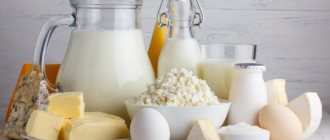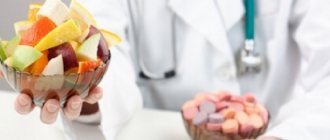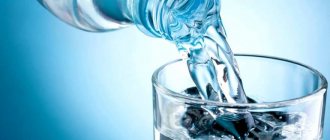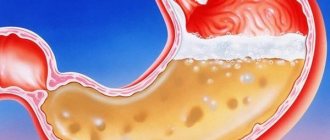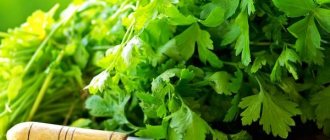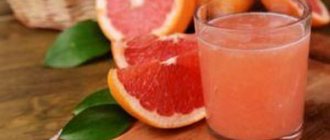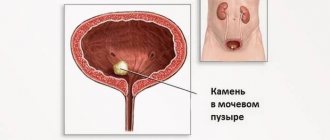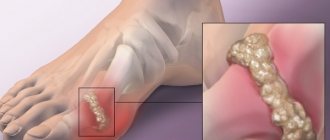989
When a person faces a problem such as increased levels of uric acid in the blood, he needs appropriate nutrition.
Uric acid is a metabolic product in the body that is formed during a process called purine metabolism. When acidity levels are high or low, it can lead to very unpleasant consequences, such as kidney disease or gout.
The essence of this deviation is that salt in the body is converted into crystals with pointed edges. Such crystals are deposited in tissues and joints, thereby causing a person severe pain when moving.
As you know, almost any treatment for a disease begins with a diet. A diet with high uric acid in the blood is no exception.
Unfortunately, those who suffer from this problem will have to adhere to proper nutrition throughout their lives.
Causes
The main causes of hyperuricemia are:
- Features of metabolism and genetic disorders. Each person's body is different, so it may turn out that it does not secrete enough enzymes that can remove uric acid. As a result, acid accumulates in the organs, leading to hyperuricemia.
- Excessive and unhealthy nutrition. Uric acid is formed as a result of the breakdown of substances called purines. In small quantities they are beneficial and have an antioxidant effect. However, when these substances are in excess, excessive amounts of acid are formed. Purines enter the body as a result of consuming foods rich in protein (eggs, fatty meats, offal), as well as alcoholic beverages.
- Side effect from medications. Most often, increased uric acid levels occur due to taking medications for heart disease and hormone therapy.
- An additional symptom to other diseases. These are mainly diseases of the kidneys and urinary system (cystitis, kidney stones), diabetes mellitus, psoriasis, cancer, obesity, atherosclerosis, etc. Hyperuricemia is also one of the components of the metabolic syndrome (a set of diseases that increase the risk of death).
- Age. With age, it becomes more difficult for the body to break down uric acid, which is why it accumulates in the internal organs.
- Hereditary factor. If a person has had problems with high levels of uric acid, then with a high degree of probability this disease can also manifest itself in his children and grandchildren.
Important! According to clinical studies, elevated levels of uric acid can be detected in 6% of the population.
However, the percentage of actually detected cases of the disease is much lower, since hyperuricemia can be asymptomatic. Therefore, it is necessary to periodically (every 1-2 years) check the amount of uric acid in the blood, especially for older people.
What foods contain purine?
In order to control the intake of purine in the body, it is necessary to have information about its content in food products. It has been proven that this compound is present in the highest concentrations in cells dividing at an increased rate (in baker's yeast), as well as in meat offal. In addition, rich sources of this substance are considered:
- meat obtained from young animals;
- mushroom, meat, vegetable and fish broths;
- jellied meat, all varieties of jellied dishes;
- sauces and gravies prepared from meat broths;
- dishes made from meat by-products;
- smoked meat (sausages, wings, ham, etc.);
- fatty fish (including canned fish);
- salty and spicy varieties of cheeses with reduced fat content;
- caviar;
- drinks that stimulate the nervous system (cocoa, rich black tea, coffee);
- all types of animal fats;
- most legumes (peas, soybeans, lentils, beans);
- products made from grapes (wine, raisins, etc.).
More detailed data on the purine content in products is presented in the table.
| List of food products | Purine content (in mg) per 100 g |
| Black tea (infusion) | 2766 |
| Cocoa powder | 1897 |
| Ground coffee | 1213 |
| Dry yeast | 761 |
| Fresh yeast | 321 |
| Chicken liver | 249 |
| Beef liver | 229 |
| Sprats | 224 |
| Herring roe | 188 |
| Calf liver | 184 |
| Saida | 167 |
| Beef lung | 167 |
| Mussels | 152 |
| Sardines, canned in oil | 147 |
| Pork kidneys | 141 |
| Pork tongue | 139 |
| Scallops | 137 |
| Pork liver | 128 |
| Halibut | 127 |
| Chicken meat | 127 |
| Smoked pork belly | 126 |
| Tuna canned in oil | 122 |
| Beef kidneys | 114 |
| Anchovies | 111 |
| Dry chickpeas | 111 |
| Raisin | 109 |
| Flax-seed | 109 |
| Beef heart | 108 |
| Raw smoked sausages | 106 |
| Sea bass | 103 |
| Venison | 102 |
| Smoked salmon | 102 |
| Soya beans | 94 |
| Herring | 89 |
| Calf kidneys | 87 |
| Trout | 86 |
| Dry lentils | 86 |
| Ham | 84 |
| Peanut | 82 |
| Artichokes | 81 |
| Dry beans | 78 |
| Lamb meat | 77 |
| Smoked mackerel | 74 |
| Lobster | 74 |
| Liver pate (any) | 74 |
| Salmon | 73 |
| Dry peas | 72 |
| Confectionery poppy | 72 |
| Tofu | 71 |
| Goose | 71 |
| Salmon | 69 |
| Beef tongue | 69 |
| Sunflower seeds | 68 |
| Cod | 66 |
| Green onion feathers | 66 |
| White chocolate | 64 |
| Veal | 64 |
| Salmon caviar | 64 |
| Pork | 64 |
| Carp | 64 |
| Green pea | 63 |
| Duck meat | 63 |
| Shrimps | 63 |
| Mackerel | 62 |
| Mutton | 62 |
| Buckwheat | 61 |
| Sesame seeds | 61 |
| Pheasant meat | 61 |
| Pike | 59 |
| Beef | 59 |
| Flounder | 59 |
| Hunter's sausages | 56 |
| Leaf salad | 54 |
| Haddock | 53 |
| Corn grains | 53 |
| Boiled sausages | 53 |
| Turkey | 51 |
| Zander | 48 |
| Meat or poultry sausages | 48 |
| Smoked eel | 47 |
| Pumpkin | 46 |
| Peanut | 44 |
| Cereals | 44 |
| Oysters | 39 |
| Blood sausage | 39 |
| Millet | 38 |
| Porcini mushrooms | 38 |
| Dried apricots | 34 |
| Quince | 33 |
| Barley | 33 |
| Marinated olives | 31 |
| Brussels sprouts | 27 |
| Watercress | 27 |
| Champignon | 26 |
| Spinach | 26 |
| Crackers | 26 |
| Cancers | 24 |
| Brazil nuts | 24 |
| Semolina | 24 |
| Blueberry | 23 |
| Broccoli | 22 |
| Dates | 22 |
| Rye | 22 |
| Cauliflower | 21 |
| Kiwi | 21 |
| Blueberry | 21 |
| Black bread | 18 |
| Savoy cabbage | 18 |
| Leek | 18 |
| White rice | 17 |
| Chanterelles | 16 |
| Celery root | 14 |
| Camembert cheese | 14 |
| Kohlrabi | 14 |
| Avocado | 14 |
| Sheep's milk cheese | 14 |
| Hazelnut | 14 |
| White cabbage | 14 |
| Crackers | 13 |
| Almond | 12 |
| Processed cheeses 20% | 12 |
| Bananas | 11 |
| Black Eyed Peas | 11 |
| Walnuts | 11 |
| Strawberry | 10 |
| Beet | 9 |
| Oranges | 9 |
| Cabbage | 9 |
| Peaches | 9 |
| Raspberries | 9 |
| Pineapples | 9 |
| Eggplant | 9 |
| Butter pastries | 8 |
| Grapes (all varieties) | 8 |
| Gouda cheese | 8 |
| Carrot | 8 |
| Fennel | 8 |
| Apples | 7 |
| Watermelons | 7 |
| Red bell pepper | 7 |
| Chicory | 7 |
| Blackberry | 7 |
| Prunes | 7 |
| Zucchini squash | 7 |
| White bread | 7 |
| Potato | 7 |
| Blueberry | 7 |
| Apricots | 6 |
| Processed cheeses 60% | 6 |
| Radish | 6 |
| Pears | 5 |
| Radish | 5 |
| Cherries | 4 |
| Tomatoes | 4 |
| Green bell pepper | 3 |
| cucumbers | 3 |
| Emmenthaler cheese | 3 |
| Onion | 3 |
| Rhubarb | 3 |
| Chicken eggs | 2 |
Diet for hyperuricemia
The main goal of a diet for hyperuricemia is to reduce the level of uric acid in the body.
This goal is achieved in the following ways:
- Reducing purine-rich foods in your daily diet.
- Introducing into the diet foods that do not contain purines or are present in small quantities.
- Introducing a large amount of liquid into the diet (at least 2 liters per day).
- Selection of products for weight loss.
Interesting article: Blood glucose levels: normal after meals and foods that lower and increase readings
Pros and cons of the method, contraindications
Doctors and nutritionists recommend following this method of eating when uric acid increases. In practice, it has shown effectiveness and rapid recovery.
The benefits of this diet:
- The exchange of purine bases is normalized.
- Prevention of stone formation and salt deposits.
- Over a short period of time, the level of uric acid decreases.
- The menu is varied, the patient does not get bored.
- No need to starve.
The only drawback of this diet is the need to avoid salt, pepper, food additives, and reduce meat consumption.
This is not easy for some patients; they have to get used to the therapeutic diet. This diet has no other disadvantages.
There are no contraindications, but if you have chronic diseases, you should consult your doctor. Individual diet adjustments are possible.
Rules for therapeutic nutrition
A diet to reduce uric acid is combined with drug treatment. Nutrition is aimed at improving metabolism.
The basis and main rule is the inclusion in the diet of foods with a small amount of purines in the composition :
- milk products;
- fruits and vegetables;
- yeast-free products;
- juices and compotes.
During a therapeutic diet, meat consumption should be significantly reduced. You can only eat boiled and stewed meat 2-3 times a week. A serving should be no more than 150-200 grams.
Interesting article: Proper nutrition and diet for high urea in the blood: products that reduce and increase urea
The diet consists of fractional meals - 5-6 times a day, with a fasting day in the middle of the week. In between meals, you need to drink plenty of fluids - 2-3 liters of liquid. Fasting is strictly prohibited, as it will lead to intense breakdown of purines. And the breakdown of purines will lead to an increase in uric acid in the body.
On a note! Depending on the severity of hyperuricemia, a therapeutic diet may last several months or may be lifelong.
Interesting article: What foods increase leukocytes in the blood: nutrition for leukemia
Approximate diet during the diet
The diet for gout and high uric acid consists of many recipes, but all of them, one way or another, involve consuming only permitted foods and only in permitted quantities. So, for breakfast you can eat a vitamin salad, the components of which are fresh carrots and a peeled apple. The products need to be grated and mixed with a spoon of low-fat sour cream.
Okroshka is also useful during this recovery period. Its composition can be ordinary (radish, cucumber, eggs, potatoes and carrots), and low-fat kefir, low-fat sour cream and a little mineral water can be used as filling. It is useful to drink a decoction of rose hips during the day, eat more apples, for dinner you can eat a potato cutlet, drink weak tea or jelly. If the patient does not have problems with excess weight, it is allowed to eat a piece of marmalade, a spoonful of jam or marmalade, and a little dark chocolate.
Table of products that reduce and increase levels
| Reduces uric acid levels | Increases uric acid levels |
|
|
Interesting article: List of products that thin the blood and prevent the formation of blood clots
What not to eat if you have high uric acid:
- almost all types of meat,
- fried fish,
- canned meat and fish,
- meat broths,
- various pickles,
- hot and salty seasonings and sauces,
- strong alcoholic drinks,
- tea,
- sweet baked goods and puff pastry products,
- mushrooms,
- sorrel,
- fruit juices, nuts.
- eggplants and corn,
But only a nutritionist or attending physician can say exactly which foods are prohibited if you have uric acid.
Menu for the week by day
The weekly diet is based on the 3-1-3 principle, i.e.
3 days of diet - fasting day - 3 days of diet. Nutrition occurs in uniform small portions 5-6 times a day every 2-3 hours (depending on sleep patterns).
1 day
Interesting article: Therapeutic diet for high blood creatinine
Day 2
Interesting article: Foods that increase insulin in the blood
Day 3
For information! During the fasting day, you should eat fruits, herbal teas and dairy products.
Traditional methods of treatment
The most common folk methods for treating hyperuricemia that lower acid in the blood are:
- Bean decoction. 1 tablespoon of bean husks should be placed in 1 liter of boiled water. Leave to boil for 2 hours. After this, strain the broth and consume 1 tablespoon 3 times a day.
- Nettle decoction. Place 20 grams of pharmaceutical nettle in a glass of boiling water for 20 minutes. After the broth has cooled, take 1 teaspoon 3 times a day.
- Lingonberry decoction. Prepare in the same way as nettle decoction, but take 1 tablespoon 3-4 times a day.
- A decoction of birch leaves. It is prepared as follows - 2 tablespoons per 400 grams of water and boil for 10 minutes. Then the broth should sit for another half hour. You should take 100 grams 4 times a day with meals.
- Foot bath with sage, chamomile and calendula. Immerse 200 grams of plant flowers (pharmacy kit) in 1.5 liters of boiling water and let it brew for 2 hours. Then prepare a foot bath. The temperature should be slightly more than 30°C. Pour a solution of sage, chamomile and calendula into the bath and immerse your feet in it. The therapeutic effect is achieved no earlier than after 5 baths, which must be taken every other day.
Interesting article: Gout: treatment and diet
Sample menu for high uric acid in the blood:
The patient's daily diet should be approximately this:
For breakfast:
- Low-fat milk, yogurt, kefir and other fermented milk drinks.
- Croutons or bran. You should fry croutons only in olive oil, not sunflower oil.
Lunch:
- Fruits: apple, orange.
- A glass of yogurt.
Dinner:
- Boiled rice.
- Vegetable salad.
- Boiled meat (if possible).
- Any fruit.
Second lunch:
- Black or green tea. Can be replaced with juice.
- Oat cookies.
Dinner:
- Zucchini and carrot puree.
- Scrambled eggs fried in olive oil.
- Low-fat yogurt.
This menu does not indicate water, which you need to drink at least two liters per day.
It is highly not recommended to eat at night during a diet.
In order to speed up the process of removing acidic substances from the body, you can prepare special decoctions.
- For example, you can make a decoction of lingonberry leaves. To do this, fresh or dry lingonberry leaves are poured with boiling water and left for about half an hour. Take one spoonful of this decoction each time before meals.
- An equally effective “helper” in normalizing the level of acidity in the body is birch decoction. Birch leaves need to be poured with boiling water, left for twenty minutes, and then taken 50 grams during meals.
Author of the article: Dubinets Alena
